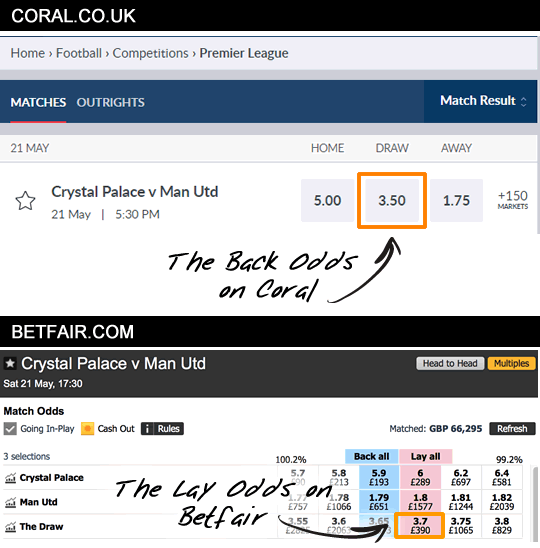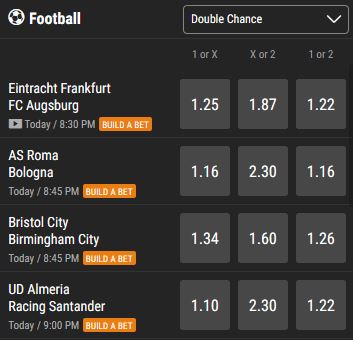0.75 means if Chelsea win by 1 goal, you will win half the bet. If Chelsea win by 2 goals, you win the full odds payout. Anything other than that, you lose your whole bet.
- What Does The Spread Mean In Football
- What Does 2.5 Mean In Sports Betting
- What Does 1-2 Goals Mean In Betting
- What Does 1 X 2 Mean In Soccer Betting
- What Does 1 1 2 Mean In Betting
- What Does 150 Mean In Betting
- Of course, betting the New York Yankees at -1.5 to bring down the odds from -190 to -110 isn’t too fun when they win 4-3 and you don’t cash a bet. Betting on the point spread is the most.
- What does this mean exactly? Consider it like a fee to broker the wager so that between one winning bet cashing and another losing based on the same -110, the book will still end up ahead between the two.
- Then you have odds-on prices such as 1/2. In this scenario, you would need to bet two units to win one back. So a £1 win on odds of 2/1 lands you £2 profit while a £1 win at 1/2 odds-on lands you £0.50 profit. So there is the risk/reward factor of betting. The longer odds of 2/1 have less of a chance of winning, while the 1/2.
The 1X2 bet, also known as match betting, full time betting or three-way betting, is a popular bet in soccer and is also found in other sports where a draw is a possible outcome. 1X2 may seem like a strange name for this bet, which can cause some confusion at first, but if you have bet on sports before then you have more than likely seen this betting option in action.
The 1X2 stands for the three outcomes possible in a game. The 1 is for an away team win, the X for a draw and the 2 for a home team win. The 1X2 markets do not provide any form of handicap, but instead the odds shown indicate the chances of each outcome occurring.
1X2 Bet Example
Here is an example of a 1X2 bet on an Premier League match from BetOnline.ag.
(1) Liverpool -208
(X) Draw +320
(2) Everton +290
As you can see a 1X2 bet is exactly the same as a typical moneyline wager with 3 possible outcomes. In this example Liverpool is a big favorite to win the game, while Everton is a big underdog.
1X2 Odds
Online sportsbooks will also offer double chance bets or no draw bets that reduce the number of possible outcomes from 3 down to 2. It is important that you perform calculations to find out if you will receive a higher return splitting your total wager among the 1X2 betting options or placing the double chance or no draw bets. Check out those pages to see the calculations.
1X2 Sports
As mentioned before 1X2 bets can be found for any sport that has three possible outcomes (home win, draw, away win). Soccer is the most popular sport for 1X2 betting, but other sports where this 1X2 bets are available include hockey and rugby among others.
If you want to come out on top against the bookies it is vital that you understand the fundamentals. When it comes to sports betting there is nothing quite as fundamental as the odds that the bookies offer. Unfortunately, betting odds can prove very confusing. That’s especially true for people who are new to betting.
That’s where this article comes in. We’re going to explain exactly how betting odds work, how they are set and the differences in the ways they are displayed. After taking in all the information below, you will be much better equipped to set about making some profit.
What Do Betting Odds Represent?
At their most basic, betting odds tell you two things:
- How much you stand to make should the selection win
- The probability of the selection winning
Take this example. If you were looking through the weekend Premier League fixtures and saw a team had fractional odds of 2/1 (that’s decimal odds of 3.0) you would know that you stand to win £2 in profit from every £1 that you stake should the team win. You’d also know that the bookmaker who set the odds ranks the team’s chances of winning as one in every three times the game is played.

If you saw a team had fractional odds of 8/13, you’d know that for every £13 you stake, you will win £8 or profit and that if the game was played 21 times in total, the bookies think the team would win 13 times and fail to win eight times (what is known as the implied probability).

What Does The Spread Mean In Football
Working out an implied probability percentage from fractional odds is simple. You just divide the stake by the combined sum of the two numbers which make up the fractional odds. In the case of 2/1 the equation looks like this:
1 / (2+1) = 0.33 or 33%
For odds of 8/13 this is the equation:
13 / (8+13) = 0.62 or 62%
That’s how the maths works but when it comes to the actual odds that bookmakers set, it’s a little more complicated.
How Do Bookmakers Set Their Odds?
The basic business model of a sportsbook is fairly uncomplicated. Bookmakers set the odds and take bets on an event. When that event ends they pay out everyone who backed the winner and then keep the rest for themselves.
But, consider the following horse race.
| Selection | Fractional Odds | Decimal Odds | Implied Probability | Profit From a £10 Bet |
|---|---|---|---|---|
| Horse 1 | Evens | 2.0 | 50% | £10 |
| Horse 2 | 3/1 | 4.0 | 25% | £30 |
| Horse 3 | 7/1 | 8.0 | 12.5% | £70 |
| Horse 4 | 7/1 | 8.0 | 12.5% | £70 |
As you can see, the combined implied probability of the selections above is 100%. From a bookmaker’s perspective that is a big problem. That’s because, presuming they’ve got the same amount of liability on each selection, they’d never make any money as they’d have to collect and payout the same amount.
So, the bookmakers will build something called an overround into their odds. Here’s a real example of a match odds market from a football match:
| Selection | Fractional Odds | Decimal Odds | Implied Probability | Profit From a £10 Bet |
|---|---|---|---|---|
| Man Utd | 1/2 | 1.5 | 66.7% | £5 |
| Draw | 18/5 | 4.6 | 21.7% | £36 |
| West Ham | 13/2 | 7.5 | 13.3% | £65 |
With an total implied probability of 101.7%, the bookmaker who set those odds is guaranteed to make a profit of 1.7% assuming that they have the same amount of liability on all three selections. Of course, it rarely works out that the bookies manage to spread their liability evenly but you need to know that when you look at a betting market you’re not simply looking at a reflection of how the bookies think the event will pan out. There’s much more going on behind the scenes.
Armed with this knowledge of how the bookmakers set their odds, you can concentrate on finding value. That is, finding a bet where you believe the odds (and therefore the implied probability) is too big. If the bookies think that a side has a 50% chance of winning but you think they’ve got a better chance than that, that’s value.
What Does 2.5 Mean In Sports Betting
The Difference Between Decimal and Fractional Odds
You will have seen above that we’ve spoken about both fractional and decimal odds. They are just different ways of conveying the same information but they do add another layer of complexity.
All the major online bookmakers will shows their odds as both fractions and decimals so it’s important that you understand just what they are showing and how to switch between the two. Thankfully, it only requires simple maths.
To go from a fraction to a decimal is as easy as dividing out the fraction and adding one. Here’s how that looks for odds of 2/1:

(2/1) + 1 = 3.o
And using our second example from above, 8/13, it looks like this:
(8/13) + 1 = 1.62
If you want to go from decimal odds to fractional odds is similarly simple. You just minus one from the decimal odds, turn that number into a fraction and reduce it down to it’s simplest form.
Let’s take decimal odds of 4.5, this is the equation:
4.5 – 1 = 3.5
35/10 -> 7/2
If the decimal price is 1.25, you convert it into fractional odds like this:
1.25 – 1 = 0.25
25/100 -> 1/4
What Does 1-2 Goals Mean In Betting
Here’s a list of some of the most common fractional odds and their decimal equivalents (for a more in-depth list click here).
| Fractional Odds | Decimal Odds | Implied Probability |
|---|---|---|
| 1/10 | 1.10 | 90.9% |
| 1/5 | 1.2 | 83.33% |
| 2/5 | 1.4 | 71.43% |
| 1/2 | 1.5 | 66.67% |
| 1/1 (evens) | 2.0 | 50% |
| 3/2 | 2.5 | 40% |
| 2/1 | 3.0 | 33.33% |
| 4/1 | 5.0 | 20% |
| 9/1 | 10.0 | 10% |
| 100/1 | 101.0 | 0.99% |
Key Terminology
When reading betting advice or searching for a value bet on the bookies’ websites you’ll come across some key terms relating to betting odds. To round up our article on betting odds, we’ve covered the most widely used terms to ensure you don’t get confused in your search for winners.
Stake – The amount of money that you place (or wager) on a specific bet.
Price – The price of a bet is simply another way of referring to the odds. You can either say that a football team can be backed at odds of 2/1or that their price is 2/1.
What Does 1 X 2 Mean In Soccer Betting

What Does 1 1 2 Mean In Betting
Odds On & Odds Against – Two of the key terms that you’ll hear when it comes to betting odds are ‘odds on’ and ‘odds against’. These terms refer to whether a price is greater or lower than evens. Any price above evens is known as odds against, while anything below evens is odds on.
What Does 150 Mean In Betting
Short and Long Odds – If something is described as being short odds it means the price is low. A long odds shot will provide you with a bigger win but is much less likely to win.